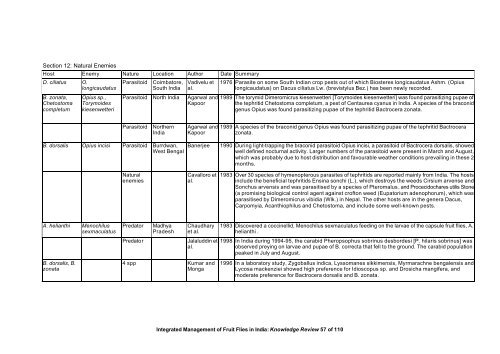“Key Informant Survey” of Production, Value, Losses and ... - DfID
“Key Informant Survey” of Production, Value, Losses and ... - DfID
“Key Informant Survey” of Production, Value, Losses and ... - DfID
You also want an ePaper? Increase the reach of your titles
YUMPU automatically turns print PDFs into web optimized ePapers that Google loves.
Section 12: Natural Enemies<br />
Host Enemy Nature Location Author Date Summary<br />
D. ciliatus O.<br />
longicaudatus<br />
B. zonata,<br />
Chetostoma<br />
completum<br />
Opius sp.,<br />
Torymoides<br />
kiesenwetteri<br />
Parasitoid Coimbatore,<br />
South India<br />
Vadivelu et<br />
al.<br />
Parasitoid North India Agarwal <strong>and</strong><br />
Kapoor<br />
Parasitoid Northern<br />
India<br />
B. dorsalis Opius incisi Parasitoid Burrdwan,<br />
West Bengal<br />
A. helianthi Menochilus<br />
sexmaculatus<br />
B. dorsalis, B.<br />
zonata<br />
Natural<br />
enemies<br />
Predator Madhya<br />
Pradesh<br />
Agarwal <strong>and</strong><br />
Kapoor<br />
1976 Parasite on some South Indian crop pests out <strong>of</strong> which Biosteres longicaudatus Ashm. (Opius<br />
longicaudatus) on Dacus ciliatus Lw. (brevistylus Bez.) has been newly recorded.<br />
1989 The torymid Dimeromicrus kiesenwetteri [Torymoides kiesenwetteri] was found parasitizing pupae <strong>of</strong><br />
the tephritid Chetostoma completum, a pest <strong>of</strong> Centaurea cyanus in India. A species <strong>of</strong> the braconid<br />
genus Opius was found parasitizing pupae <strong>of</strong> the tephritid Bactrocera zonata.<br />
1989 A species <strong>of</strong> the braconid genus Opius was found parasitizing pupae <strong>of</strong> the tephritid Bactrocera<br />
zonata.<br />
Banerjee 1990 During light-trapping the braconid parasitoid Opius incisi, a parasitoid <strong>of</strong> Bactrocera dorsalis, showed<br />
well defined nocturnal activity. Larger numbers <strong>of</strong> the parasitoid were present in March <strong>and</strong> August,<br />
which was probably due to host distribution <strong>and</strong> favourable weather conditions prevailing in these 2<br />
months.<br />
Cavalloro et<br />
al.<br />
Chaudhary<br />
et al.<br />
Predator Jalaluddin et<br />
al.<br />
4 spp Kumar <strong>and</strong><br />
Monga<br />
1983 Over 30 species <strong>of</strong> hymenopterous parasites <strong>of</strong> tephritids are reported mainly from India. The hosts<br />
include the beneficial tephritids Ensina sonchi (L.), which destroys the weeds Cirsium arvense <strong>and</strong><br />
Sonchus arvensis <strong>and</strong> was parasitised by a species <strong>of</strong> Pteromalus, <strong>and</strong> Procecidochares utilis Stone<br />
(a promising biological control agent against cr<strong>of</strong>ton weed (Eupatorium adenophorum), which was<br />
parasitised by Dimeromicrus vibidia (Wlk.) in Nepal. The other hosts are in the genera Dacus,<br />
Carpomyia, Acanthiophilus <strong>and</strong> Chetostoma, <strong>and</strong> include some well-known pests.<br />
1983 Discovered a coccinellid, Menochilus sexmaculatus feeding on the larvae <strong>of</strong> the capsule fruit flies, A.<br />
helianthi .<br />
1998 In India during 1994-95, the carabid Pheropsophus sobrinus desbordesi [P. hilaris sobrinus] was<br />
observed preying on larvae <strong>and</strong> pupae <strong>of</strong> B. correcta that fell to the ground. The carabid population<br />
peaked in July <strong>and</strong> August.<br />
1996 In a laboratory study, Zygoballus indica, Lyssomanes sikkimensis, Myrmarachne bengalensis <strong>and</strong><br />
Lycosa mackenziei showed high preference for Idioscopus sp. <strong>and</strong> Drosicha mangifera, <strong>and</strong><br />
moderate preference for Bactrocera dorsalis <strong>and</strong> B. zonata.<br />
Integrated Management <strong>of</strong> Fruit Flies in India: Knowledge Review 57 <strong>of</strong> 110

















